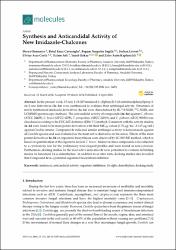Synthesis and Anticandidal Activity of New Imidazole-Chalcones

Göster/
Erişim
info:eu-repo/semantics/openAccessTarih
2018Yazar
Osmaniye, DeryaKaya Çavuşoğlu, Betül
Sağlık, Begüm Nurpelin
Levent, Serkan
Çevik, Ulviye Acar
Atlı Eklioğlu, Özlem
Kaplancıklı, Zafer Asım
Üst veri
Tüm öğe kaydını gösterÖzet
In the present work, 15 new 1-(4-(1H-imidazol-1-yl)phenyl)-3-(4-substituedphenyl) prop-2-en-1-one derivatives (3a-3o) were synthesized to evaluate their antifungal activity. Structures of newly synthesized imidazole derivatives (3a-3o) were characterized by IR, H-1-NMR, C-13-NMR, and LCMSMS spectroscopic methods. The anticandidal activity of compounds (3a-3o) against C. albicans (ATCC 24433), C. krusei (ATCC 6258), C. parapsilosis (ATCC 22019), and C. glabrata (ATCC 90030) was elucidated according to the EUCAST definitive (EDef 7.1) method. Consistent with the activity studies, 3a-3d were found to be more potent derivatives with their MIC50 values (0.78 mu g/mL-3.125 mu g/mL) against Candida strains. Compound 3c indicated similar antifungal activity to ketoconazole against all Candida species and was evaluated as the most active derivative in the series. Effects of the most potent derivatives 3a-3d on ergosterol biosynthesis were observed by LC-MS-MS method, which is based on quantification of the ergosterol level in C. krusei. Moreover, these compounds were subjected to a cytotoxicity test for the preliminary toxicological profiles and were found as non-cytotoxic. Furthermore, docking studies for the most active derivative 3c were performed to evaluate its binding modes on lanosterol 14-alpha-demethylase. In addition to in vitro tests, docking studies also revealed that Compound 3c is a potential ergosterol biosynthesis inhibitor.

















